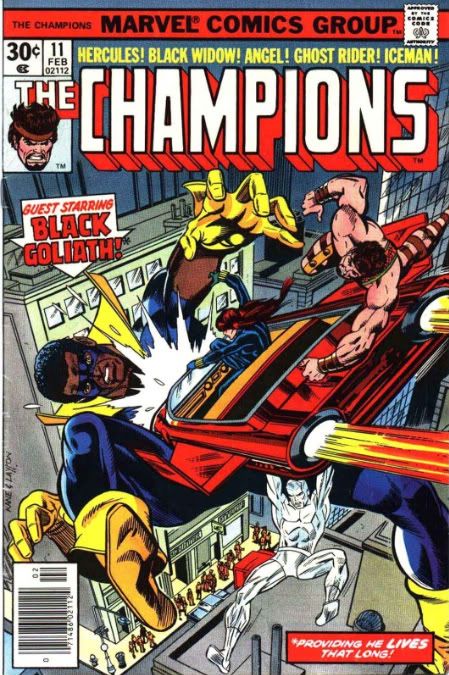
Click here for commentary on issue #1
Click here for commentary on issue #2
Click here for commentary on issue #3
The Champions was a short-lived superhero team book that I was basically interested in because one of my favorite characters, Ghost Rider, was a member. (I remember being excited that the team was going to guest in [I think] the third issue of Marvel’s Godzilla book, and how bitterly disappointed I was that Ghost Rider was not among them when the issue came out.)
However, the odd roster of team members, ex-X-men Angel and Iceman (mutants), Hercules (a god), the Black Widow (an ex-Russian spy) and GR (a man uneasily co-existing with a demon), never caught on with the fans. The book was canceled after 17 issues in mid-stride, and it wasn’t til like a year or two later, in a one-page flashback in Peter Parker The Spectacular Spider-Man, that puzzled Marvelites learned the story behind the team’s dissolution.
This is actually sort of a ‘historical’ issue, in that it’s the first book penciled by John Byrne, who soon moved onto the X-Men and became comicdom’s premiere artist. Here his pencils aren’t quite as sure as they would become–obviously–and inker Bob Layton laid over them in such a way that the art smacks as much of his stuff as Byrne’s. Even so, much of the stuff is eye-popping.
We enter in mid-action, as Hercules, BW, Angel and Iceman plummet towards the ground in their malfunctioning Sky-Car. They manage to pull up, but still look to crash until the handy appearance of guest star Black Goliath, who grows to giant proportions and stops the Sky-Card by grabbing it. BG almost falls off the roof of the Champions building due to the momentum, but Iceman creates an ice platform extension under him and he’s saved. Funny how nobody ever slips off those, since, you know, they’re ice.
Even here we got a sense that Byrne was a surprisingly gifted artist. He was one of the first comic book pencilers whose black characters actually looked black because of their features, and not merely because they were colored that way.
Soon we cut out to the “deserts of Arizona” where motorcyclist Johnny Blaze is enjoying some solitude. At this point he changed to Ghost Rider whenever there was danger about, and so is shocked when he begins transforming. This is a great issue for GR, who seldom was graced by the better writers and artists. I fell in love with Byrne when I saw his GR, who really looks cool. He went with the burning skull that still had eyes, and Ghost Rider looks quite spooky here. As well, he gets a lot of play in this story, and frankly, the next several issues of the Champions book were among the best Ghost Rider appearances in his long history.
After nearly being crushed by a cattle stampede, GR whips up his hellfire bike and rides out of danger’s way by racing up and horizontally along the wall of a canyon, one of his niftier skills. Soon the stampede is cut off by the efforts of arrow-slinger Hawkeye of the Avengers, along with his then sidekick The Two-Gun Kid, who traveled in time from…oh, never mind. Anyway, the trio soon spot a flying saucer (!!) hovering over (bum bum bum) The Mesa of Lost Souls. This stuff is a lot easier to swallow when the art’s so good.
Seeing a newscast, the rest of the Champions climb back into their freshly repaired Sky-Car and jet off to join their errant member. It’s a good thing, too, for they face the Warlord Kaa, an alien shadow being who with his underlings can take over a human’s mind by merging with his shadow.
Several pretty decent pages of superhero antics follow, with Kaa being disposed of in a fairly nifty fashion, before Ghost Rider hellfires up an arrow that Hawkeye uses to get rid of the rest of Kaa’s crew. However, the triumphant heroes can’t rest long, for they get a telecast message from Black Goliath back at their headquarters, which is under attack by the venerable (if somewhat goofy) villain Stiltman.
It’s with Byrne’s introduction that the book really started to come together, but sadly, it was too late. This is a good issue, and certainly a nice change of pace from the last few comic books I’ve looked at here. The action is plentiful and exciting, and under the pen of writer Bill Mantlo, the various characters are all comparatively well written and given distinct personalities and motivations. We’re not talking Alan Moore here, but it’s good, clean scripting.
Ghost Rider especially had some nice moments in upcoming issues, such as the reason behind his hostility towards fledgling teammate Darkstar, and his running feud with Iceman. While the team’s fans were apparently few, I doubt I was the only one who was sorry that we never got to see the promised square-off between the two.
I used to have a dream storyline for bringing the group back together, although eventually other stories interfered with my ideas. Still, if you’re looking for some decent superhero stuff, you could do a lot worse than to spend a couple of bucks on eBay and pick up the last eight or nine issues of this book.
